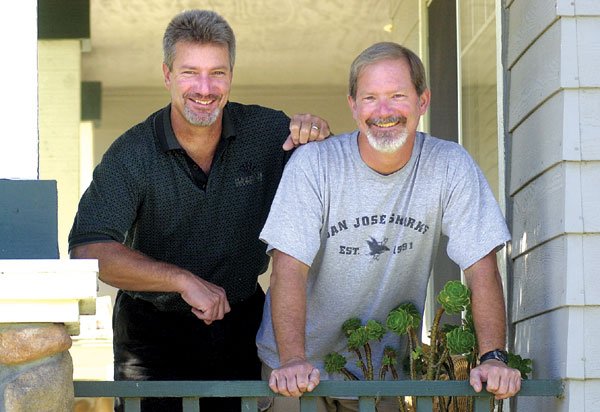Sandra Simmons is going to be busy soon, very busy. The
30-year-old Hollister resident is currently pregnant with her first
children
– fraternal twins who are the result of fertility
treatments.
”
Everyone has an opinion about everything,
”
said Simmons.
”
I just know that we’re going to need a lot of support from our
family, but I had to sign forms that I understood and that I knew I
might have twins (when I started treatment). They consider them a
side effect, but I don’t mind. My mindset was, it would be great to
have two.
”
Sandra Simmons is going to be busy soon, very busy. The 30-year-old Hollister resident is currently pregnant with her first children – fraternal twins who are the result of fertility treatments.
“Everyone has an opinion about everything,” said Simmons. “I just know that we’re going to need a lot of support from our family, but I had to sign forms that I understood and that I knew I might have twins (when I started treatment). They consider them a side effect, but I don’t mind. My mindset was, it would be great to have two.”
Around the United States, an increasing number of parents are finding themselves in a similar situation as fertility treatments, which can cause multiple births, become more accessible and medical science gives even the tiniest preemies more hope of survival. Since 1980, twin births have increased by 42 percent nationwide and multiple births have shot up 178 percent, according to Internet sites run by the Fordham Health Sciences Library at Wright State University in Dayton, Ohio and Mothers of Supertwins in East Islip, New York.
Images of twins are scattered throughout popular culture, from the plot lines of daytime soap operas and the silver screen to gossip column shots of the Olsen twins and beer commercials featuring buxom blond double-takes. But being a twin means more than looking alike – fraternal twins don’t even need to be the same sex – it’s a special bond of intimacy and a special challenge in parenting, according to Susan Kohl, a mother of identical twin boys and the Sonora, Calif.-based author of “Twin Stories: Their Mysterious and Unique Bond.”
In researching her book, Kohl interviewed 150 sets of twins ages 6 to 86 to learn about their pasts, their relationships and their views on life.
“I think the most interesting thing I found is that, with most identical and same-sex twins, there is definitely an emotional bond, a physical bond and a spiritual bond,” said Kohl. “The spiritual bond really came from people who had lost their twins, but the emotional and physical bonds are pretty firmly set.”
In her research, Kohl found twins who felt their siblings die, who woke up with identical wounds though only one had been injured and who felt profoundly spiritually connected to their other half. In one case, a woman checked herself into an emergency room for severe abdominal pains, not realizing that her twin sister, halfway across the country, was at that moment delivering her first child.
“I wouldn’t say the special types of communication twins have was a myth,” said Kohl. “It doesn’t happen for everyone, but a member of twins that I interviewed had that connection.”
Helping children to understand their separate identities is every bit as important as celebrating their special bonds, though, according to Kohl and Maureen Doolan Boyle, director of the East Islip, New York-based group Mothers of Supertwins.
“Back in the 50s and 60s, it was considered really cute and common for parents to dress up their multiples in the same clothes,” said Doolan Boyle, a mother of five including one set of triplets. “Now it’s not encouraged. You would expect and you would hope that they would have a very different sense of self, so you have to make sure that the individual child, from a very early age, develops an individual identity.”
And while sibling rivalries can be intense among single sets of twins in one family, the social dynamics of supertwins, twin sets of three or more in the same family, can be quite different, said Doolan Boyle.
“If you’re having a typical sibling fight, it doesn’t get big,” said Doolan Boyle. “You just turn around and have someone else to play with, so it diffuses the tension. Also, it’s much more difficult to have a spoiled multiple since it’s harder to give immediate individual attention. I think the first expression my children understood was, ‘in a minute.'”
What is harder is giving a multiple child a sense of self, said Doolan Boyle. Unlike regular twins, who are often separated into different classrooms so they can build distinct social groups, multiples are harder to split up, she said.
“There’s actually a portion of MOST’s Web site that’s devoted to supertwins’ civil rights,” said Doolan Boyle. ‘It’s important for each child to be appreciated for who they are. The first words we taught our children to say were their names. That way they would be able to correct people.”
As an example, Doolan Boyle pointed to an experience her triplets had their first year of high school.
“My daughter, who’s a fraternal twin to her identical brothers, was talking to someone while they got on the bus,” said Doolan Boyle. “Her brother came up and sat
a row in front of them, and they all started talking. The boy was surprised my daughter knew one of his friends and she was able to respond, ‘I knew him before he was born, and he’s older than me.’ They were wombmates, and nothing in the world can change that, but they’re also their own people.”
Single twin sets can face intense rivalries, especially when parents push them to compete, said Kohl.
“I’ve interviewed many twin sets where the parents did the competition thing – with grades, with sports, with friends – and now they hate their twin,” said Kohl.
“They hate acknowledging that they’re a twin or they don’t speak. It all started with things like, if one guy got invited to a sleepover, making sure that the other guy went or always making sure they were together.”
Many twins do embrace their individuality, said Kohl, expressing themselves through different clothing choices, musical tastes and groups of friends. Her own boys, Sam and Max, become fiercely loyal to different bands and select differently themed clothing. It’s a way of life Gilroy resident Greg Birnie remembers well.
“I think we got equal attention, and it was convenient having a twin because we could share stuff when we were doing sports, but as far as scholastics, we kept to ourselves,” said Birnie, a fraternal twin. “We were competitive in sports and sometimes we were competitive as to who we had as our friends because we wanted our friends to ourselves.”
Most twins progress through a few stages of togetherness and individuality during their lifetimes, said Doolan Boyle. Identicals may discover the ability to fool others about their identity and attempt to swap places in early elementary school, but by ages 8 through 11, they begin to separate their interests, she said. This gap continues to widen between the ages of 11 and 15, she said.
“Generally, throughout high school they would be developing different friendships, different interests,” said Doolan Boyle.
“As they go to college, that’s going to be the first time that they’ll have decided if they want to be together or not, and it will also probably be the first time that people will not even have a clue that they’re a multiple, but will develop perceptions of them as an individual.”
The separation that many teenage twins force on themselves is a normal part of their identity formation, said Doolan Boyle, and many come back to their close relationships as life settles into place.
“They come back knowing who they are and that they bring something totally different to their family dynamic,” said Doolan Boyle. “By the time they generally have their first child, just like many people will return to their roots, to the church of their childhood, they do that with their siblings.”
Today, Birnie and his twin brother, who lives in Sunnyvale, share special time fishing and watching sports.
“Sometimes we make the same call – we’ll say there’s going to be an interception – during a football game,” said Birnie. “We’ll say the same thing even though we’re in different cities, but we’re very close.”














